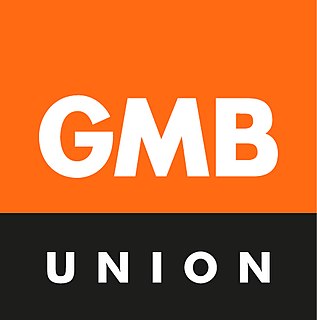Related Research Articles

The GMB is a general trade union in the United Kingdom which has more than 631,000 members. Its members work in nearly all industrial sectors, in retail, security, schools, distribution, the utilities, social care, the National Health Service (NHS), ambulance service and local government.

The Transport and General Workers' Union was one of the largest general trade unions in the United Kingdom and Ireland – where it was known as the Amalgamated Transport and General Workers' Union (ATGWU) to differentiate itself from the Irish Transport and General Workers' Union – with 900,000 members. It was founded in 1922 and Ernest Bevin served as its first general secretary.

William Guthrie Spence, Australian trade union leader and politician, played a leading role in the formation of both Australia's largest union, the Australian Workers' Union, and the Australian Labor Party.
The National Transport Workers' Federation (NTWF) was an association of British trade unions. It was formed in 1910 to co-ordinate the activities of various organisations catering for dockers, seamen, tramwaymen and road transport workers.
The Dock, Wharf, Riverside and General Labourers Union (DWRGLU), often known as the Dockers' Union, was a British trade union representing dock workers in the United Kingdom.
The Workers' Union was a general union based in the United Kingdom, but with some branches in other countries. During the 1910s, it was the largest general union in the UK, but it entered a rapid decline in the 1920s, and eventually became part of the Transport and General Workers' Union (TGWU).

The Irish Transport and General Workers Union (ITGWU), was a trade union representing workers, initially mainly labourers, in Ireland.
The National Amalgamated Labourers' Union (NALU) was a trade union representing unskilled labourers in the United Kingdom.
The National Amalgamated Coal Workers' Union was a trade union in the United Kingdom which existed between 1889 and 1922. It represented coal porters and carmen.
The United Order of General Labourers was a trade union representing labourers, mostly in the construction industry, in the United Kingdom.
The National Association of Operative Plasterers (NAOP) was a trade union representing plasterers in the United Kingdom.
The Municipal Employees' Association was a trade union representing local government workers in the United Kingdom.

The National Society of Operative Printers and Assistants (NATSOPA) was a British trade union.
The National Union of General Workers (NUGW) was an early general union in the United Kingdom, the most important general union of its era.
The United Textile Factory Workers' Association (UTFWA) was a trade union federation in Great Britain. It was active from 1889 until 1975.
The National Federation of Building Trades Operatives (NFBTO) was a trade union federation in the United Kingdom, consisting of unions with members in construction and related industries.
The United Builders' Labourers Union was a trade union representing labourers in the construction industry in the United Kingdom.
Peter Joseph Tevenan was an Irish trade unionist and politician.
Ralph Spence was a British trade unionist.
The Kent and Sussex Agricultural Labourers' Union was a trade union representing farm workers in South East England.
References
- 1 2 3 Arthur Ivor Marsh, Historical Directory of Trade Unions, p.475
- ↑ National Amalgamated Union of Labour Annual Reports
- 1 2 3 Clegg, H. A. (1954). General Union. Oxford: Basil Blackwell. pp. 15–22.
- ↑ Labour Party, Report of the Executive Committee (1918), pp.115
- ↑ F. W. S. Craig, British Parliamentary Election Results 1885-1918
| This article related to a United Kingdom trade union is a stub. You can help Wikipedia by expanding it. |